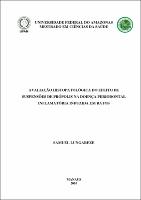| ???jsp.display-item.social.title??? |


|
Please use this identifier to cite or link to this item:
https://tede.ufam.edu.br/handle/tede/3651| ???metadata.dc.type???: | Dissertação |
| Title: | Avaliação histopatológica do efeito de suspensões de própolis na doença periodontal inflamatória induzida em ratos. |
| ???metadata.dc.creator???: | Lungareze, Samuel  |
| ???metadata.dc.contributor.advisor1???: | Bandeira, Maria Fulgência Costa Lima |
| ???metadata.dc.description.resumo???: | A doença periodontal (DP) está intimamente associada com a formação de biofilme dental, podendo progredir para formação de uma bolsa periodontal. A própolis tem sido utilizada como produto medicinal desde 300 a.C., e apresenta como características: atividades anticancerígena, antioxidante, anti-inflamatória, antimicrobiana e antifúngica. A atividade antimicrobiana da própolis frente aos periodontopatógenos já foi investigada através de testes in vitro e in vivo, principalmente através de extratos etanólicos. O presente trabalho teve como objetivo avaliar histologicamente a resposta da DP inflamatória induzida no tecido periodontal de ratos após a utilização de suspensões aquosas de própolis (SAP) a 0,1%, 1% e 10%, para irrigação subgengival. Foram utilizados 84 ratos wistar (Rattus novergicus), pesando entre 210 e 290g, com oito semanas de idade, distribuídos nos seguintes grupos experimentais: grupo I (n=14, SAP a 0,1%), grupo II (n=14, SAP a 1%), grupo III (n=14, SAP a 10%), grupo IV (n=14, Solução de Tween 80 a 5%), grupo V (controle positivo, n=14, com DP induzida e sem tratamento), grupo VII (n=14, clorexidina a 2%) e grupo VI (n=84, controle negativo, dentes contralaterais não induzidos e não tratados nos animais dos grupos I, II, III, IV, V e VII). A DP inflamatória foi induzida através da técnica da ligadura com fios de algodão durante um período de 15 dias na cervical do 1º molar inferior esquerdo. Após a remoção do fio a bolsa periodontal foi irrigada 3 vezes (1º, 4º e 7º dias) com as Soluções testes e o sacrifício foi realizado com 15 e 30 dias após o tratamento. Foi realizado teste exato de Fisher (p-valor 0,05). Analisando comparativamente os resultados pode-se sugerir que a SAP foi eficiente considerando principalmente a resposta inflamatória em curto prazo (15 dias) e na concentração de 0,1%, associada à presença de fibras gengivais densas, vasos sanguíneos sem congestão, ausência de reabsorções dentárias e perdas ósseas, podendo ser uma alternativa de tratamento da DP necessitando de estudos futuros para demonstrar a viabilidade biológica na utilização como coadjuvante na terapêutica periodontal. |
| Abstract: | The Periodontal disease (DP) is very strongly associated with the dental biofilm and may evolve the formation of a periodontal pocket. The propolis has been used as a medicinal product since 300 b.C, and has the following characteristics: anti-cancer activities, antioxidant, anti-inflammatory, antimicrobial, and antifungal. The propolis antimicrobial activity in face of periodontalpatogens has been investigated though in vitro and in vivo tests, mainly with the etanolic extracts. The following paper had as an objective evaluate the histological response of the inflammatory DP induced on the rats periodontal tissue after the use of a watery suspension of propolis (SAP), at 0,1%, 1%, and 10%, for subgingival irrigation. Was used 84 wistar rats (Rattus novergicus), weighting between 210 and 290g with eight weeks old. They were distributed in the following experimental groups: group I (n= 14, SAP at 0,1%), group II (n=14, SAP at 1%), group III (n=14, SAP at 10%), group IV (n=14, Tween`s solution 80 at 5%), group V (positive control, n=14, with induced DP and without treatment), group VII (n=14, chlorhexidine at 2%) and group VI (n=84, negative control, not induced contralateral teeth and not treated on animals of groups I, II, III, IV, V e VII). The inflammatory DP was induced with the technique that uses the ligation with cotton yarn during a period of 15 days on the cervical of the first left inferior molar. After the removal of the yarn the periodontal pocket was irrigated 3 times (1st, 4th and 7th days) with the tests solution and the sacrifice was done on the 15th and 30th day after treatment. Was done the test exact of Fisher (p-value 0,05). Analyzing comparatively the results you may suggest that the propolis suspension on the concentration of 0,1% is efficient considering the short term inflammatory response (15 days), associated to the presence of dense gingival fibers, blood vessels without congestion, no dental reabsorption and bone loss. There for may be used as an alternative treatment for the periodontal disease, needing further studies to demonstrate the biological viability on the use as supporting on the periodontal therapeutic. |
| Keywords: | Própolis Irrigação Subgengival Bolsa Periodontal Periodontite Ratos. Propolis Subgingival irrigation Periodontal pocket Periodontitis Rats. |
| ???metadata.dc.subject.cnpq???: | CIÊNCIAS DA SAÚDE |
| Language: | por |
| ???metadata.dc.publisher.country???: | BR |
| Publisher: | Universidade Federal do Amazonas |
| ???metadata.dc.publisher.initials???: | UFAM |
| ???metadata.dc.publisher.department???: | Faculdade de Medicina |
| ???metadata.dc.publisher.program???: | Programa de Pós-graduação em Ciências da Saúde |
| Citation: | Lungareze, Samuel. Avaliação histopatológica do efeito de suspensões de própolis na doença periodontal inflamatória induzida em ratos.. 2010. 99 f. Dissertação (Mestrado em Ciências da Saúde) - Universidade Federal do Amazonas, Manaus, 2010. |
| ???metadata.dc.rights???: | Acesso Aberto |
| URI: | http://tede.ufam.edu.br/handle/tede/3651 |
| Issue Date: | 15-Jan-2010 |
| Appears in Collections: | Mestrado em Ciências da Saúde |
Files in This Item:
| File | Description | Size | Format | |
|---|---|---|---|---|
| Dissertacao Samuel Lungareze.pdf | 4.47 MB | Adobe PDF |  Download/Open Preview |
Items in DSpace are protected by copyright, with all rights reserved, unless otherwise indicated.




